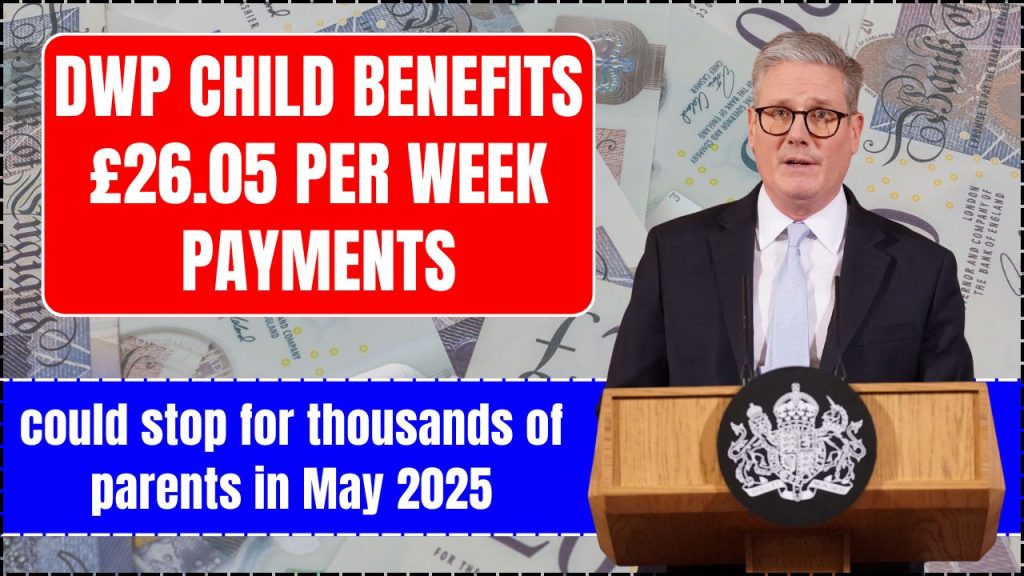
Many families across the UK rely on Child Benefit as a crucial part of their household income. However, thousands of parents could face an unexpected financial shock at the end of May 2025, as these payments may abruptly stop without proper action. This essential support, which provides £26.05 weekly for the first child and £17.25 for additional children, requires specific steps to maintain eligibility, particularly for families with 16-year-olds in education or training.
Current Child Benefit Rates for 2025-26
Child Benefit has seen a modest increase in the 2025-26 financial year, with rates rising by 1.7% compared to the previous year:
| Child | Weekly Rate | 4-Weekly Rate | Annual Amount |
|---|---|---|---|
| First or only child | £26.05 | £104.20 | £1,354.60 |
| Additional children (per child) | £17.25 | £69.00 | £897.00 |
These payments provide vital financial support to over 7.6 million households across the UK, helping with the costs of raising children from birth until they reach adulthood.
Why May 2025 Is a Critical Deadline
May 31, 2025, represents a significant cut-off date for many families claiming Child Benefit. For parents with children who have continued in education past 16 but then left their course in early 2025, payments will automatically terminate at this quarterly deadline unless specific actions are taken.
5 Key Reasons Why Your Child’s Benefit Might Stop
1. Your Child Has Turned 16 and Left Education
Child Benefit automatically stops on August 31st following a child’s 16th birthday unless HMRC is notified that they will continue in approved education or training. This is the most common reason for payment termination.
2. Failure to Confirm Education Status with HMRC
Even if your child is continuing their education, HMRC requires confirmation of this status. The department typically sends letters to parents during their child’s final school year before they turn 16, or before they turn 18/19 if continued education was previously confirmed. Failing to respond to these communications will result in your payments automatically stopping.
3. Completion of Approved Education or Training
When your child completes or leaves their approved education or training, Child Benefit payments will stop at the next quarterly cut-off date: February, May 31, August 31, or November 30, whichever comes first. For many students finishing courses in spring 2025, May 31 is the relevant deadline.
4. Starting Advanced Education
Child Benefit is only payable for children in non-advanced education. If your child has moved on to advanced education, such as a university degree course or BTEC Higher National Certificate, you’ll no longer be eligible for Child Benefit payments.
5. Beginning Paid Training or Apprenticeship
If your child starts paid training where they receive a wage (including certain types of apprenticeships), this may disqualify you from receiving Child Benefit. Only unpaid approved training qualifies for continued payments.
What Qualifies as Approved Education or Training?
To continue receiving Child Benefit beyond your child’s 16th birthday, they must be enrolled in what HMRC considers “approved education or training.”
Approved Education Must Be:
- Full-time (more than 12 hours a week of supervised study)
- Can include: A-levels, T-levels, Scottish Highers, NVQs up to level 3, home education (if started before age 16 or after with special educational needs), GCSEs, and pre-university Foundation years (non-advanced)
- Your child must have been accepted onto the course before their 19th birthday
Approved Training Programs Include:
- In England: Foundation Apprenticeships or Traineeships
- In Wales: Foundation Apprenticeships, Traineeships, or Jobs Growth Wales+ scheme
- In Scotland, Foundation Apprenticeships or the No One Left Behind scheme
- In Northern Ireland: PEACEPLUS Youth programme, Training for Success, or Skills for Life and Work
Most importantly, the training must generally be unpaid to qualify for continued Child Benefit.
How to Prevent Your Child’s Benefit from Stopping
Taking proactive steps can ensure your Child Benefit continues without interruption if your child remains eligible:
1. Respond Promptly to HMRC Communications
If you receive any letter or email from HMRC asking about your child’s education status, respond immediately with the requested information.
2. Proactively Update HMRC
Even without receiving a formal notification, you should inform HMRC if your child is continuing in education or training. This can be done through several channels:
- Online through your Government Gateway account: www.gov.uk.
- Via the free HMRC app
- By phone: Call the Child Benefit Helpline on 0300 200 3100
- By post: Write to the Child Benefit Office with details of your child’s education plans
3. Report Changes Promptly
If your child’s circumstances change – such as switching courses, taking a break from education, or leaving education entirely – you must inform HMRC promptly to avoid potential overpayments that you may later be required to repay.
4. Check for Extension Eligibility
In some circumstances, you may qualify for a 20-week extension of Child Benefit if your child leaves education or training and registers with a careers service or joins the armed forces. You must apply within 3 months of your child leaving education.
Wider Implications When Child Benefit Stops
The termination of Child Benefit can affect other aspects of your finances:
Impact on Other Benefits
If you receive Universal Credit or Child Tax Credits, these will also be affected when your child no longer qualifies as a dependent. You must inform both HMRC and the Department for Work and Pensions (DWP) of changes to your child’s education status.
National Insurance Credits
Even if your income is too high to receive Child Benefit payments due to the High Income Child Benefit Charge, registering for Child Benefit provides National Insurance credits that count toward your State Pension. Consider claiming but opting out of receiving payments if your household income exceeds £60,000.
Your Child’s National Insurance Number
Children registered for Child Benefit automatically receive their National Insurance number before they turn 16 – another reason to maintain your claim, even if you opt out of receiving payments.
Important Dates to Remember
Mark these critical deadlines in your calendar to ensure your Child Benefit payments continue without interruption:
- 31 May 2025: Payments will stop for children who have left education or training since February 2025
- 31 August 2025: The next quarterly cut-off date when payments will stop for children leaving education or training after May 2025
- 30 November 2025: The subsequent quarterly cut-off date
DWP Child Benefits £26.05 Per Week. Payments could stop for thousands of parents in May 2025. Know the Reasons and take action now to avoid disruption to this vital financial support. With proper planning and communication with HMRC, eligible families can ensure their payments continue without interruption.
How to Check Your Current Child Benefit Status
If you’re unsure about your current Child Benefit status or payment schedule, you can:
- Check your payment details through your Government Gateway account at www.gov.uk.
- Use the HMRC app to view your payment details and claim status
- Contact the Child Benefit Helpline on 0300 200 3100 (Monday to Friday, 8 am to 6 pm)
Future Changes to Child Benefit in 2025-26
HMRC has announced some changes to Child Benefit administration taking effect in 2025:
- Digital Service Expansion: A new digital service launching in summer 2025, allowing families to pay the High Income Child Benefit Charge through their PAYE tax code
- Automatic Enrollment: Plans to streamline the Child Benefit application process for new parents
Official Resources
For more information and official guidance on Child Benefit, visit these government websites:
- Child Benefit when your child turns 16
- How to claim Child Benefit
- Check if a change affects your Child Benefit
- How and when your benefits are paid
- DWP benefits statistics

Katherine Johnson is a passionate writer with a keen interest in storytelling, content creation, and creative expression. She enjoys exploring diverse topics and crafting engaging narratives that captivate readers.



